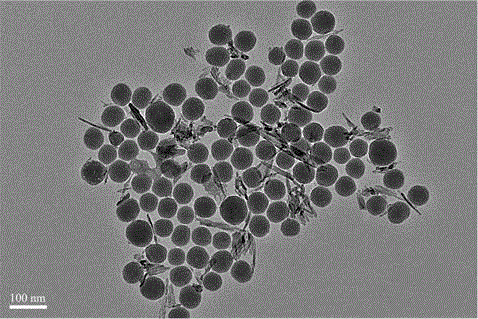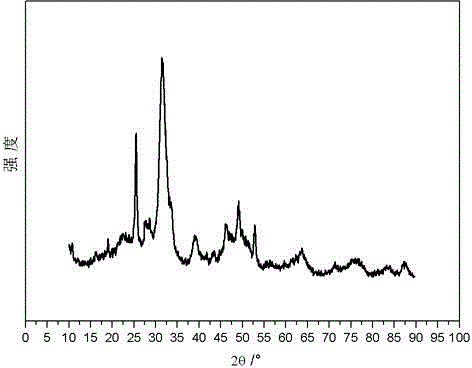Silicon oxide-calcium phosphate class composite nano-filler and preparation method thereof
A nano-filler and silicon oxide technology, applied in medical science, prosthesis, etc., to achieve the effects of easy industrialization, good dispersibility, and strong modifiability
- Summary
- Abstract
- Description
- Claims
- Application Information
AI Technical Summary
Problems solved by technology
Method used
Image
Examples
Embodiment 1
[0024] Mix 7ml of TEOS (tetraethyl orthosilicate) and 160ml of ethanol evenly, heat up to 50°C; then mix 7ml of ammonia water, 9ml of water and 20ml of ethanol into the above mixture, and continue the reaction for 5 hours. Stop heating, then stir at room temperature for 12 hours to obtain silicon oxide alcohol sol A; adjust the pH value of A to 10 with ammonia water, add 30 ml of KH570, and mix it with 5 ml of 0.5M diammonium hydrogen phosphate solution to obtain a mixed solution B; 8.2 milliliters of calcium nitrate solutions are added dropwise to the B solution at a certain rate to obtain solution C, and are continuously stirred at a certain rate during the dropping process; after the C solution is aged for 20 hours, acetone is used to carry out multiple centrifugal separation and washing, and then The silica-hydroxyapatite composite nanoparticles were obtained by freeze-drying. Such as figure 1 and 2 Shown are TEM (transmission electron microscope photos) and XRD (X-ray d...
Embodiment 2
[0026] Mix 7ml of TEOS (tetraethyl orthosilicate) and 160ml of ethanol evenly, and heat up to 50°C; then mix 9ml of ammonia water, 9ml of water and 20ml of ethanol into the above mixture, and continue to react for 4 hours. Stop heating, then stir at room temperature for 4 hours to obtain silicon oxide alcohol sol A; adjust the pH value of A to 10 with ammonia water, add 30 ml of KH570, and mix it with 5 ml of 0.5M diammonium hydrogen phosphate solution to obtain a mixed solution B; 8.2 milliliters of calcium nitrate solutions are added dropwise to the B solution at a certain rate to obtain solution C, and are continuously stirred at a certain rate during the dropping process; after the C solution is aged for 20 hours, acetone is used to carry out multiple centrifugal separation and washing, and then The silica-hydroxyapatite composite nanoparticles were obtained by freeze-drying.
Embodiment 3
[0028] Mix 9ml of TEOS (tetraethyl tetrasilicate) and 160ml of ethanol evenly, and control the temperature at 30°C; then mix 9ml of ammonia water, 9ml of water and 20ml of ethanol into the above mixture, and continue to react for 12 hours , stop heating, and then stir at room temperature for 48 hours to obtain silicon oxide alcohol sol A; adjust the pH value of A to 5 with ammonia water, add 30 ml of KH570, mix it with 5 ml of 0.5M diammonium hydrogen phosphate solution, and obtain a mixed Solution B; 8.2 milliliters of calcium nitrate solutions are added dropwise to the B solution at a certain rate to obtain solution C, and the dripping process is continuously stirred at a certain rate; after the C solution is aged for 20 hours, ethanol is used to carry out multiple centrifugation and washing, and then Silica-calcium phosphate composite nanoparticles are obtained by freeze-drying.
PUM
| Property | Measurement | Unit |
|---|---|---|
| particle diameter | aaaaa | aaaaa |
| length | aaaaa | aaaaa |
Abstract
Description
Claims
Application Information
 Login to View More
Login to View More - R&D
- Intellectual Property
- Life Sciences
- Materials
- Tech Scout
- Unparalleled Data Quality
- Higher Quality Content
- 60% Fewer Hallucinations
Browse by: Latest US Patents, China's latest patents, Technical Efficacy Thesaurus, Application Domain, Technology Topic, Popular Technical Reports.
© 2025 PatSnap. All rights reserved.Legal|Privacy policy|Modern Slavery Act Transparency Statement|Sitemap|About US| Contact US: help@patsnap.com


